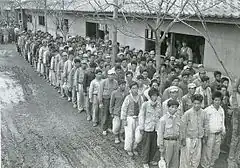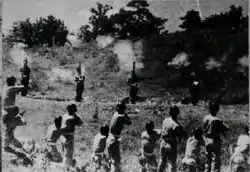| Part of the Korean War | |
 National Defense Corps soldiers in January 1951 | |
| Date | December 1950 – February 1951 |
|---|---|
| Cause | Inadequate supplies due to embezzlement of funds |
| Convicted | Kim Yoon Keun and four other officers |
| Sentence | Death by firing squad |
| Korean name | |
| Hangul | 국민방위군 사건 |
| Hanja | 國民防衛軍事件 |
| Revised Romanization | Gungminbangwigun Sageon |
| McCune–Reischauer | Kungminbangwigun Sagŏn |

The National Defense Corps Incident was a death march that occurred between December 1950 and February 1951, during the Korean War, as a result of corruption.[1] (Incident refers to both the deaths from starvation during the retreat and the corruption which led to the deaths.)[1]
Background
On 11 December 1950, South Korea issued an act establishing the National Defense Corps. South Korean citizens aged 17 to 40, excluding military, police and government officials, were drafted into the National Defense Corps.[2][3] The Syngman Rhee government then adopted officers from the pro-Rhee Great Korean Youth Association into the Corps.[4]
March
406,000 drafted citizens were deployed in 49 training units.[5] The National Defense Corps soldiers were then ordered to march south. However, funds for food purchases were embezzled by the National Defense Corps Commander Kim Yun-geun (김윤근; 金潤根; also spelled Kim Yoon-keun or Kim Yungun), son-in-law of Defense Minister Shin Song-mo.[6] This led to the deaths of numerous soldiers from either malnutrition or frostbite.
Number of deaths and casualties
By June 1951, when an investigating committee made known its findings, it was reported that some 50,000[7] to 90,000 soldiers starved to death or died of disease on the march and in the training camps.[3][6][8]
Figures vary on the number of deaths and casualties. According to a 13 June 1951 article in the New York Times, approximately 300,000 men were lost to death or desertion over a three-week, 300-mile march.[9]
According to a 2021 article in Foreign Policy by S. Nathan Park, 120,000 soldiers died from frostbite and malnutrition.[10]
Aftermath
On 30 April 1951, the National Assembly of South Korea adopted a resolution on disbandment of the National Defense Corps.[2] The National Assembly investigation showed that the commanding officers embezzled one billion won, and tens of millions of won was misappropriated to President Syngman Rhee's political fund.[7]
In May 1951, vice-president Yi Si-yeong resigned. In June, it was reported that five billion won in funds for the National Defense Corps had been embezzled.[11] On 12 August 1951, five commanding officers were executed as persons in charge of the incident.[2][12]
See also
References
- 1 2 "국민방위군 National Defence Incident". Encyclopedia of Korean Culture (in Korean). Retrieved 13 September 2023.
- 1 2 3 "Jinsilhwahaewi 'gugminbang-wigun' jiggwonjosa" 진실화해위 `국민방위군' 직권조사 [Truth and Reconciliation 'National Defense Force' ex officio investigation]. Yonhap News (in Korean). Newsis. 9 March 2007. Retrieved 14 July 2010.
- 1 2 Terence Roehrig (2001). Prosecution of Former Military Leaders in Newly Democratic Nations: The Cases of Argentina, Greece, and South Korea. McFarland & Company. p. 139. ISBN 978-0-7864-1091-0.
- ↑ Tucker, Spencer C.; Pierpaoli Jr., Paul G. (2010). The Encyclopedia of the Korean War: A Political, Social, and Military History, 2nd Edition [3 volumes]: A Political, Social, and Military History. ABC-CLIO. p. 475. ISBN 9781851098507.
- ↑ ""Gugminbang-wigun sumanmyeong hangugjeonttae heomanghan jug-eum" ganbudeul-i gunsupum chagbog…gulm-eojuggeona jeon-yeombyeong hoengsa jinsilhwahaewi, maejangji deung hwag-in…gugga-e sagwa gwongo" "국민방위군 수만명 한국전때 허망한 죽음" 간부들이 군수품 착복…굶어죽거나 전염병 횡사 진실화해위, 매장지 등 확인…국가에 사과 권고 [“Tens of thousands of people in the National Guard died in vain during the Korean War.” Officials embezzle military supplies… Confirmation of the truth about starvation or violent death from an infectious disease, burial place, etc… apology to the state] (in Korean). Hankyoreh. 7 September 2010.
- 1 2 Sandler, Stanley. The Korean War: no victors, no vanquished. University Press of Kentucky. p. 224. ISBN 978-0-8131-0967-1 – via Google Books.
- 1 2 국민방위군 사건 (in Korean). National Archives of Korea. Archived from the original on 27 April 2011. Retrieved 20 July 2010.
- ↑ '국민방위군' 희생자 56년만에 '순직' 인정. Newsis (in Korean). 30 October 2007. Retrieved 14 July 2010.
- ↑ "50,000 KOREANS DIE IN CAMPS IN SOUTH; Government Inquiry Confirms Abuse of Draftees--General Held for Malfeasance". The New York Times. US. 13 June 1951. p. 3. Retrieved 22 July 2010.
More than 50,000 South Korean draftees have died of starvation or disease since last December in training camps, the chairman of an investigating committee said today....[T]he investigation committee had substantiated ... the details of a 300-mile 'death march'.... During the three weeks of forced marching through snow in the bitter cold of winter, [the investigator] said, approximately 300,000 men deserted or died along the way.
- ↑ Park, S. Nathan (5 September 2021). "Korea Was the United States' First Forever War". Foreign Policy. Retrieved 22 June 2023.
- ↑ "SOUTH KOREAN AIDE QUITS; Defense Minister Says He Was Implicated in Scandals". The New York Times. US. 4 June 1951. Retrieved 22 July 2010.
- ↑ "ROK General Executed for Army Thefts". Los Angeles Times. US. 14 August 1951. p. 6. Archived from the original on 3 November 2012. Retrieved 22 July 2010.